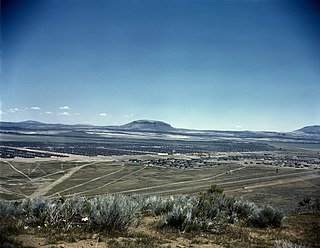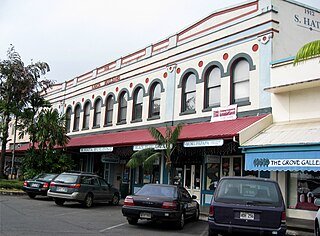Related Research Articles

During World War II, the United States forcibly relocated and incarcerated at least 125,284 people of Japanese descent in 75 identified incarceration sites. Most lived on the Pacific Coast, in concentration camps in the western interior of the country. Approximately two-thirds of the inmates were United States citizens. These actions were initiated by president Franklin D. Roosevelt via an executive order shortly after Imperial Japan's attack on Pearl Harbor.

The Hawaiian Volcano Observatory (HVO) is an agency of the U.S. Geological Survey (USGS) and one of five volcano observatories operating under the USGS Volcano Hazards Program. Based in Hilo, Hawaii, the observatory monitors six Hawaiian volcanoes: Kīlauea, Mauna Loa, Kamaʻehuakanaloa, Hualālai, Mauna Kea, and Haleakalā, of which, Kīlauea and Mauna Loa are the most active. The observatory has a worldwide reputation as a leader in the study of active volcanism. Due to the relatively non-explosive nature of Kīlauea's volcanic eruptions for many years, scientists have generally been able to study ongoing eruptions in proximity without being in extreme danger.

The Gila River War Relocation Center was an American concentration camp in Arizona, one of several built by the War Relocation Authority (WRA) during the Second World War for the incarceration of Japanese Americans from the West Coast. It was located within the Gila River Indian Reservation near the town of Sacaton, about 30 mi (48.3 km) southeast of Phoenix. With a peak population of 13,348, it became the fourth-largest city in the state, operating from May 1942 to November 16, 1945.

The Tule Lake National Monument in Modoc and Siskiyou counties in California, consists primarily of the site of the Tule Lake War Relocation Center, one of ten concentration camps constructed in 1942 by the United States government to incarcerate Japanese Americans forcibly removed from their homes on the West Coast. They totaled nearly 120,000 people, more than two-thirds of whom were United States citizens.

Minidoka National Historic Site is a National Historic Site in the western United States. It commemorates the more than 13,000 Japanese Americans who were imprisoned at the Minidoka War Relocation Center during the Second World War.

The Amache National Historic Site, formally the Granada War Relocation Center but known to the internees as Camp Amache, was a concentration camp for Japanese Americans in Prowers County, Colorado. Following the Japanese attack on Pearl Harbor on December 7, 1941, Japanese Americans on the West Coast were rounded up and sent to remote camps.

The Japanese American National Museum is located in Los Angeles, California, and dedicated to preserving the history and culture of Japanese Americans. Founded in 1992, it is located in the Little Tokyo area near downtown. The museum is an affiliate within the Smithsonian Affiliations program.

The Jerome War Relocation Center was a Japanese American internment camp located in southeastern Arkansas, near the town of Jerome in the Arkansas Delta. Open from October 6, 1942, until June 30, 1944, it was the last American concentration camp to open and the first to close. At one point it held as many as 8,497 detainees. After closing, it was converted into a holding camp for German prisoners of war. Today, few remains of the camp are visible, as the wooden buildings were taken down. The smokestack from the hospital incinerator still stands.

The Rohwer War Relocation Center was a World War II Japanese American concentration camp located in rural southeastern Arkansas, in Desha County. It was in operation from September 18, 1942, until November 30, 1945, and held as many as 8,475 Japanese Americans forcibly evacuated from California. The Rohwer War Relocation Center Cemetery is located here, and was declared a National Historic Landmark in 1992.

The S. Hata Building is a historic structure in Hilo, Hawaii built by Japanese businessman Hata Sadanosuke in 1912. It now contains specialty shops, professional offices, and a Cafe Pesto restaurant.
Yasutaro (Keiho) Soga was a Hawaiian Issei journalist, poet and activist. He was a community leader among Hawaii's Japanese residents, serving as chief editor of the Nippu Jiji, then the largest Japanese-language newspaper in Hawaii and the mainland United States, and organizing efforts to foster positive Japan-U.S. relations and address discriminatory legislation, labor rights and other issues facing Japanese Americans. An accomplished news writer and tanka poet before the war, during his time in camp Soga authored one of the earliest memoirs of the wartime detention of Japanese Americans, Tessaku Seikatsu or Life Behind Barbed Wire.
Honouliuli National Historic Site is near Waipahu on the island of Oahu, in the U.S. state of Hawaii. This is the site of the Honouliuli Internment Camp which was Hawaiʻi's largest and longest-operating internment camp, opened in 1943 and closed in 1946. It was designated a National monument on February 24, 2015, by President Barack Obama. The John D. Dingell, Jr. Conservation, Management, and Recreation Act, signed March 12, 2019, redesignated it as Honouliui National Historic Site. The internment camp held 320 internees and also became the largest prisoner of war camp in Hawaiʻi with nearly 4,000 individuals being held. Of the seventeen sites that were associated with the history of internment in Hawaiʻi during World War II, the camp was the only one built specifically for prolonged detention. As of 2015, the new national monument is without formal services and programs.
Thomas Tameichi Sakakihara, referred to locally as Tommy Sakakihara in person and in print, was a Japanese American politician from Hawaii, interned due to his ancestry during World War II.
Henry Yuzuru Sugimoto was a Japanese-American artist, art teacher and a survivor of Japanese American Internment during World War II. Sugimoto became a naturalized citizen of the United States in 1952.

Kīlauea Military Camp (KMC) is operated as a Morale, Welfare and Recreation (MWR) facility on Hawai‘i Island, also known as the Big Island, in Hawaiʻi. It is located inside Hawaiʻi Volcanoes National Park. This United States Department of Defense (DOD) facility is at an elevation of 4,000 feet, within walking distance from Kilauea Volcano, the world’s most active volcano.

Hiroshi Honda (1910–1970) was an American painter who was born in Hilo, Hawaii to Japanese parents who had immigrated to Hawaii at the turn of the twentieth century. He was sent to Kumamoto at age 6 to study and help with the family business, and while there studied sumi-e ink painting. He was conscripted into the Japanese Air Force as a young man, and served for seven years before being wounded and discharged. He returned to Hilo in 1939 and took a job teaching at a local Japanese language school, occasionally doing commercial painting work on the side. In 1940, he met a Nisei woman, Sadako Hashida, and the couple married and moved to Honolulu soon after.
Tokiji "Sojin" Takei (April 6, 1903 – July 23, 1991) was a Japanese poet and essayist who lived in Hawaii. He was a prolific writer who is best known for his poetry written while he was incarcerated in a series of internment camps.
Otokichi "Muin" Ozaki was a Japanese tanka poet who lived in Hawaii.
Motokazu "Taisanboku" Mori was a Japanese surgeon and tanka poet who practiced in Hawaii.
Chinyei Kinjo (金城珍栄)(December 21, 1899 – March 3, 1987) was an Okinawan journalist. He ran the Yoen jiho for most of its 49-year history.
References
- ↑ "George Hoshida". Janm.org. Retrieved 2014-05-20.
- ↑ "George Hoshida Collection | Collections | Japanese American National Museum". Janm.org. Retrieved 2014-05-20.